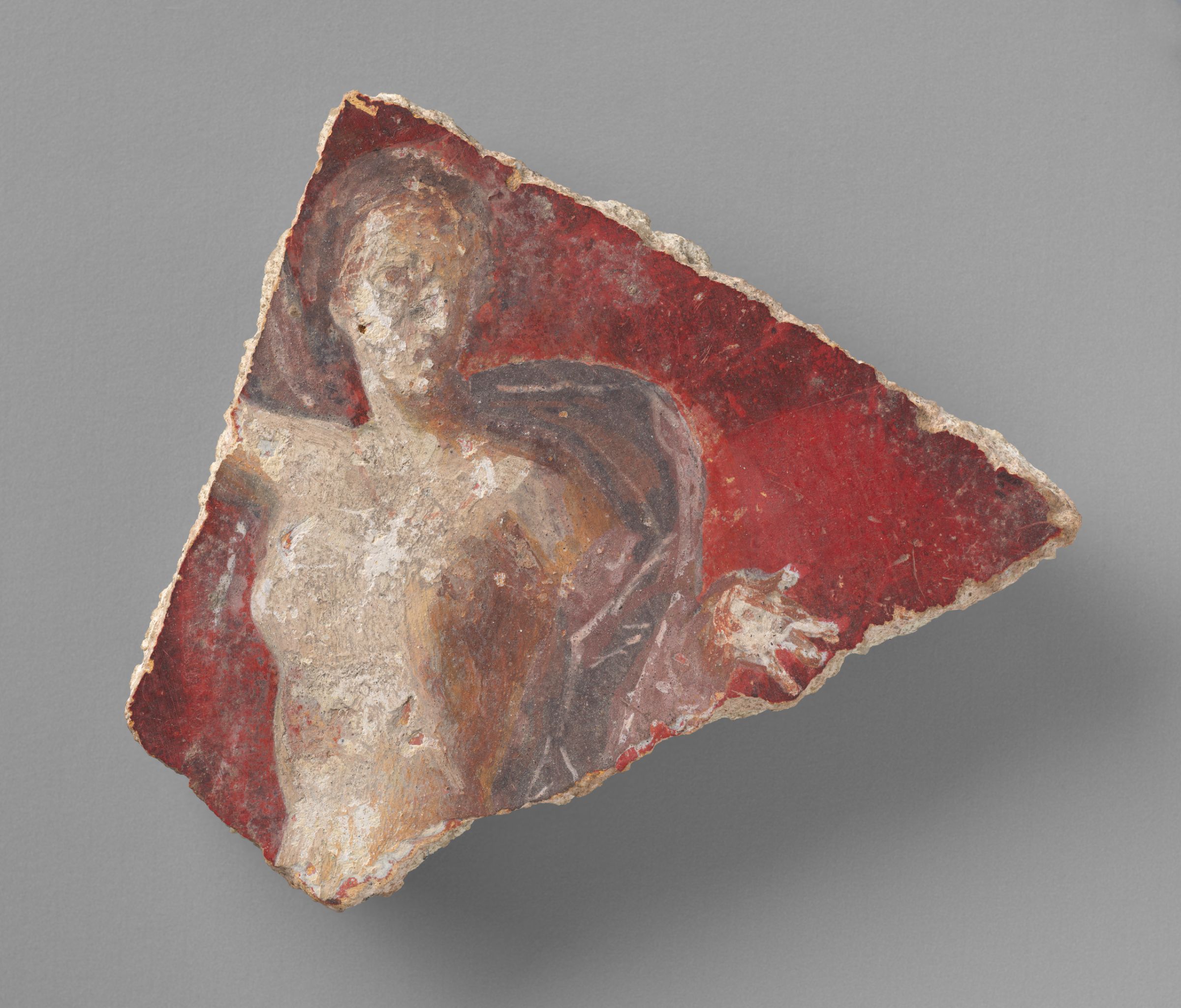1939.145: Mosaic Pavement with Birds, from Feleet Village Building (Panel B)
MosaicsA large bird in the center top spreads its wings. A large section is missing from the bottom, leaving behind only a portion of a large peacock tail on lower left, and the head, neck, and partial back of another bird on the lower right. The mosaic’s very small pieces depict recognizable details in the standing birds such as eyes, beaks, feet, wings, and feathers. There’s a suggestion of a partial outline of a twelfth bird on the right side, where a board is missing. The colors are muted, missing sections are grey or tan.
Identification and Creation
- Object Number
- 1939.145
- Title
- Mosaic Pavement with Birds, from Feleet Village Building (Panel B)
- Classification
- Mosaics
- Work Type
- mosaic
- Date
- 4th-5th century CE
- Places
- Creation Place: Ancient & Byzantine World, Asia, Antioch (Syria)
- Period
- Roman Imperial period, Late
- Culture
- Roman
- Persistent Link
- https://hvrd.art/o/291656
Physical Descriptions
- Medium
- stone and glass tesserae
- Dimensions
- H. 180 x W. 245 x D. 38.1 cm (70 7/8 x 96 7/16 x 15 in.)
Provenance
- Recorded Ownership History
- Excavated from a building near the Feleet Village (Turkey, Hatay) by the Syrian Department of Antiquities (later the Hatay government) and the Committee for the Excavation of Antioch and Its Vicinity, (1936), dispersed; to Fogg Art Museum, 1939.
Acquisition and Rights
- Credit Line
- Harvard Art Museums/Arthur M. Sackler Museum, Gift of the Committee for the Excavation of Antioch and its Vicinity
- Accession Year
- 1939
- Object Number
- 1939.145
- Division
- Asian and Mediterranean Art
- Contact
- am_asianmediterranean@harvard.edu
- Permissions
-
The Harvard Art Museums encourage the use of images found on this website for personal, noncommercial use, including educational and scholarly purposes. To request a higher resolution file of this image, please submit an online request.
Descriptions
- Description
-
This polychrome mosaic floor pavement depicts twelve birds on a plain, white background framed by a decorative, guilloche border in shades of green, yellow, and red. In the center of the panel stands a large bird, probably an eagle that faces forward bearing its breast and spreading its wings.
In the lower register of the panel, two peacocks face one another. A peacock tail is preserved in the lower left composed of purple, pink, and green tesserae. The head of a second bird appears in the lower right. The peacock’s tail is rendered as a vertical plane and the feathers are carefully positioned in a repeating, stylized pattern. The remaining nine birds are spread throughout the panel and include such species as a goose, pheasant, and partridge (1). Tesserae in shades of yellow, brown, green, gray and purple create limited modeling the birds' forms.
1. Levi identifies the birds as a heron, duck, partridge, and parrot. For parrots, see House of the Beribboned Parrots; for an eagle in the same pose at Antioch see the House of Dionysus and Ariadne (Levi II, pl. CLXXIX.a)
- Commentary
-
Birds, particularly peacocks, are among the most popular subjects in mosaics and the motif of mirrored peacocks is found in several other pavements at Antioch where the two birds flank a vessel, often a kantharos or basket filled with grapes (1). Often associated with the goddess Hera/Juno in mythology, peacocks were considered sacred and held a variety of meanings in Roman art including eternal life (2).
The panel comes from an unidentified structure, possibly a domestic space, in the Feleet Village area near Daphne, a suburb of Antioch in modern-day Turkey. It was found, along with a second mosaic of the same subject, during the 1936 excavations led by the Committee for the Excavation of Antioch and its Vicinity.
Notes:
1. For similarly stylized peacocks see those in the upper level of the House of Bird Rinceau, upper level (Doro Levi, Antioch Mosaic Pavements (Princeton University Press, 1947), pl. CLXXXI.d) and Worcester Museum inv. 1936.23. For birds in Roman mosaics consult Antero Tammisto, "Birds in Mosaics," Acta Instituti Romani Finlandiae,18 (1997).
2. For an ancient source consult Ovid, Metamorphoses I, 622-723. The peacock was also considered a counterpart for the eagle of Zeus/Jupiter, as seen in this example, Anna Gonosova, "Mosaic with Peacocks," in The Arts of Antioch, (Princeton University Press, 2005), 238-242. Christine Kondoleon, Domestic and Divine: Roman Mosaics in the House of Dionysos (Ithaca: Cornell University Press, 1994), 109.
Publication History
- Antioch On-the-Orontes III, Edited by Richard Stillwell: The Excavations 1937-1939 (Princeton University, 1941), p. 181, cat. 117, pl. 54 (section 2)
- Doro Levi, Antioch Mosaic Pavements, Princeton University Press (Princeton, 1947), p. 348, fig. 141
- Doro Levi, Antioch Mosaic Pavements, Princeton University Press (Princeton, 1947), pl. CLXXX
Subjects and Contexts
- Roman Domestic Art
Related Digital Tours
Verification Level
This record has been reviewed by the curatorial staff but may be incomplete. Our records are frequently revised and enhanced. For more information please contact the Division of Asian and Mediterranean Art at am_asianmediterranean@harvard.edu
